
152 Administrator’s Guide SurfControl RiskFilter - E-mail V5.2.4
R
ISK
F
ILTER
S
YSTEM
M
ANAGEMENT
C
ONSOLE
The RiskFilter Tab
5
A lower MX preference number gives higher priority than a lower one. In Figure 5-25, e-mail is sent in the
following way:
• E-mail sent to site A.com round-robins between mail exchangers 1, 2,and 3, because each RiskFilter
appliance has the same MX preference of 5.
• The same thing happens for e-mail sent to site B.com. If site A is down (e.g., with a network failure), the
sending mail server will route e-mail to the fourth (failover) MX record, which is the address of a server
in a different physical location.
For the described failover to work properly, RiskFilter appliances at site A are configured to accept
messages for site B, and RiskFilter appliances at site B are configured to accept messages for site A.
The failover servers have static routes configured so that RiskFilter knows where to route the e-mail. There
are also advanced load-balancing switches that can be used for these purposes. These switches offer a
variety of load-balancing algorithms, in addition to round-robin delivery, which provide efficient load distri-
bution and timely failover. Using load-balancing switches may improve the overall efficiency of your SMTP
infrastructure.
RiskFilter in a cluster set up. You can set up RiskFilter in a cluster and use the wizard to set the IPs of
the master and slave/s:
Figure 5 - 26 RiskFilter in a cluster set up
• Internet – E-mails coming into slave. Slaves can only be accessed via port 25 from the internet.
• Network 1 – Used for communication between master and slave.
• Network 2 – The network where the internal servers lie. This network holds mail servers and the
RiskFilter administration clients.
To configure multiple NICs, see Multi-NIC configuration in RiskFilter on page 142.


















